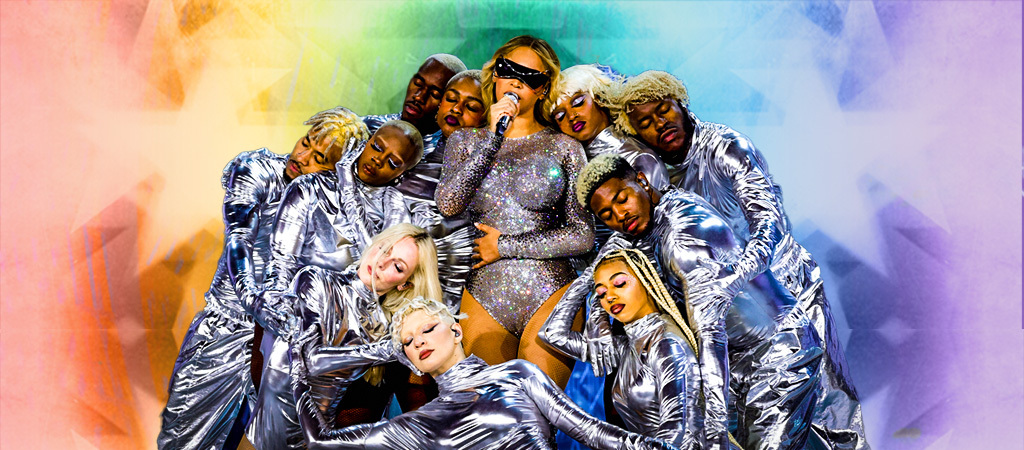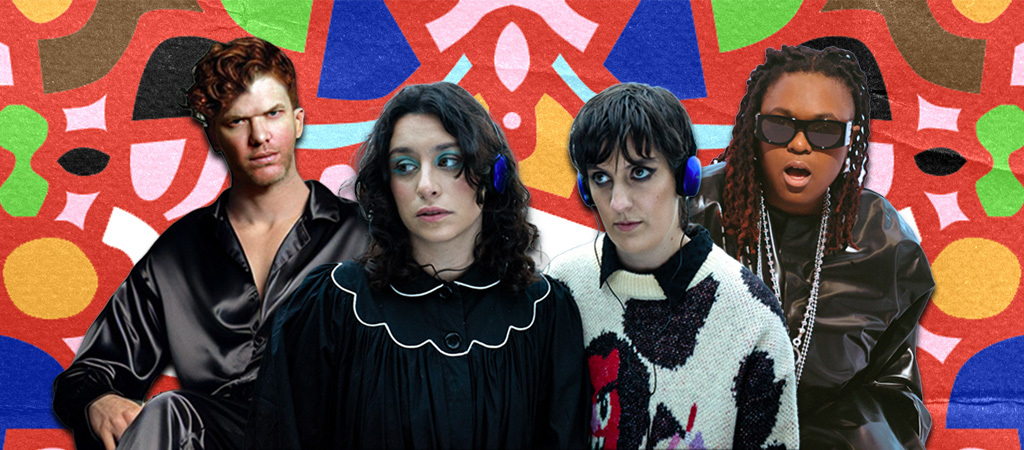
At the beginning of Renaissance: A Film By Beyoncé, the legendary entertainer is seen opening up the stage for one of her Inglewood shows, which took place on her birthday. During her remarks, Beyoncé hammers home that the world encapsulated within the various arenas during the Renaissance World Tour is a free universe, where each audience member is encouraged to express themselves.
“I’m thankful to be able to provide a safe space for all of y’all,” she says to a cheering audience, dressed to the nines in their flashy, glimmering outfits. Throughout the nearly three-hour-long concert film, which doubles as a documentary, fans get a look at the hard work that went into the tour — which, in and of itself, took four years of planning. The Beyhive also learns more about Bey’s childhood with her late Uncle Jonny, who inspired the Renaissance era, and her concerted efforts to celebrate the LGBTQ+ community and ballroom culture.
In the liner notes of Beyoncé’s Renaissance album, Bey offers a dedication to the openly gay Jonny. “He was my godmother and the first person to expose me to a lot of the music and culture that serve as an inspiration for this album. The album itself features many samples from the ballroom era, as Bey breathes new life into these underground classics that served as an escape for Jonny and the queer community. This is especially true of “Pure/Honey,” a song from the album that features a prominent sample of “C*nty” by Kevin Aviance. While “C*nty” was a hit in the late ‘90s within the ballroom scene, Aviance says he felt he didn’t get his 10s during that time.
“I found myself doing more Club Kid stuff in downtown New York City,” says Aviance. “Hosting parties, and stuff like that.”
Aviance says he found out that Bey used the “C*nty” sample at the same time everyone else did, and remembers a feeling of pure elation as he arrived to the 15th track on Renaissance.
“I mean, someone taking my baby and revamping her and making her feel c*nty again — it was incredible,” says Aviance. “The song never let me down in any way, shape, or form. I’ve never stop performing it. So it’s just one of the things that is such a staple in our community. It means a lot to a lot of people, and it was so nice to see that it meant something to Beyoncé.”
Over the course of the Renaissance World Tour, Aviance hosted drag shows and after-parties in various cities. As a ballroom figure and former Club Kid, Aviance says he’s found himself “in and out” of his career. But since Bey breathed new life into “C*nty” through Renaissance, he has been nabbing gigs left and right, and says he’s currently booked until July 2024.
“I’m in limbo a lot sometimes,” says Aviance, “but I’m always working and something happens, and with this, people started going back to my catalog, and were visiting my shows. I’m still riding that high.”
Producer and mash-up DJ Amorphous is also experiencing a new breakthrough during the Renaissance era. The 25-year-old artist known for his viral mash-ups earned a spot on the tour’s musical arrangement team — a connection he had been manifesting for six years.
Back in 2017, Amorphous went viral after dropping an album he made featuring Beyoncé and Jay-Z mashups. One of the mixes caught wind of the husband-wife duo and was used during their joint On The Run II Tour in 2018. Amorphous made this discovery after seeing a video clip of dancers rehearsing with the mashup playing in the background.
“I remember freaking out about that, because I’m like, ‘Oh, my God, so that must mean that she knows who I am,’’ says Amorphous. Though a working relationship wouldn’t come to fruition for another five years, Bey kept Amorphous inspired.
When Renaissance dropped in 2022, Amorphous released a mashup featuring the album’s “Plastic Off The Sofa” and Solange’s “Cranes In The Sky.” Bey later used the clip in one of her Instagram reels. “So then. I really knew like, ‘Okay, she absolutely has to know who I am.”
Though he’s not sure how his role on the tour came to fruition, he remembers someone from Bey’s team hitting him up to join them on tour.
Amorphous’ passion for music production dates back over a decade, when he discovered the transcendental sounds of queer, ballroom-inspired artists like LSDXOXO, Cakes Da Killa, and MikeQ. A then self-described “preppy, quaker school student,” Amorphous would get lost in this music, and he would once again gravitate toward these sounds when creating his mix for the Renaissance World Tour.
His time on the tour came as a full circle moment, but also as a pleasant indicator of what’s to come.
“As a queer artists, I’d look back to the little version of me that didn’t want to be here anymore,” says Amorphous. “I was struggling coming to terms with my sexuality or my identity, and I would sit in at the computer while my friends would go out during recess, or when my cousins were over to play video games, I would be on the computer creating and honing in my craft, whether that was music or film. So to have that translate through the joy of just creating to being able to work directly with Beyoncé, to being credited in my first Hollywood film, it’s a weird place to be in. Because you look back at those moments of self-doubt, when you were asking yourself ‘Do you want to come out? Do you want to be yourself? And I’m just so proud that I’ve stuck to that. And it’s something that I want to continue to stick with in the future.”
This likely won’t be Amorphous’ first go-around with Queen Bey, as she tends to keep her collaborators close, like family.
This is the case with dancer and choreographer Jonte Moaning, who has been working with Beyoncé since The Beyoncé Experience Tour in 2007. He’s also choreographed several of her videos, including “Freakum Dress” and “Single Ladies.” In the Renaissance film, viewers will immediately notice Moaning’s impeccable moves, as well as his vibrant hair pieces and colorful makeup. Having worked with Bey for nearly two decades, Moaning has become familiar with all the moving parts of a Beyoncé-level production.
“I also work with wardrobe. I work with hair, and I work with the technicians,” says Moaning. “I need to know everything that’s happening. I need to know the whole body in order for me to be my best self. You know what I mean? Because when I walk in, I want to make sure that everybody knows that they’re respected.”
Originally from Portland, Moaning recalls moving to New York City in the early 2000s during the Club Kid era, quickly becoming “a spectator of the world of ballroom.” Keeping his finger on the pulse of the world of dance, Moaning has kept his momentum amid rapidly changing dance trends and platforms.
Moaning was discovered by Beyoncé during the dawn of YouTube, on which Moaning created his dance channel shortly after the video-sharing service’s launch. YouTube launched just over a year after Janet Jackson and Justin Timberlake’s 2004 controversial Super Bowl Halftime performance, for which, Moaning was also a dancer.
Moaning has often displayed his confidence through his moves and his fashion, remaining unapologetically queer, and defying gender norms by design. “Even in places where you would be very uncomfortable to walk around,” Moaning says, he found community within Beyoncé’s team, and with the Beyhive. One of his fondest memories of the tour surprisingly came from a stop in Kentucky.
“Kentucky was like so dry,” Moaning says. “I looked outside of my f*cking hotel window and I saw, like, dust bunnies rolling down the street. It was desolate, there was nothing there. But that day, I went out to get a new hairpiece for the show, and there was this small boutique that had trinkets and cute dresses, and it was full of people who were getting ready to go to that show the next day. When we performed there were like, 60,000 people there, and they were all decked out, ready to go.”
Throughout the Renaissance film, we see that Beyoncé does not cut a single corner. With an internal team comprised of over 400 people — the best lighting crew, the best make-up artists, the best costume designers, and more — Beyoncé spotlights the community that delivered the show, as well as honoring the communities that came before her and inspired the entire Renaissance era.
“Can you imagine doing a world tour with over 400 people traveling with them every single day?” says Moaning. “Every single day, I stepped into the stadium and said hello to 400 different people. When you travel with so many different groups of people, you get to see so many different types of individuals, and you learn to work with them, and we become family.”

